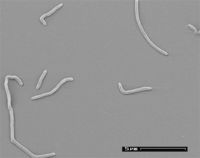Natranaerobius thermophilus: Difference between revisions
(→Author) |
|||
| Line 24: | Line 24: | ||
==References== | ==References== | ||
[Sample reference] [http://ijs.sgmjournals.org/cgi/reprint/50/2/489 Takai, K., Sugai, A., Itoh, T., and Horikoshi, K. "''Palaeococcus ferrophilus'' gen. nov., sp. nov., a barophilic, hyperthermophilic archaeon from a deep-sea hydrothermal vent chimney". ''International Journal of Systematic and Evolutionary Microbiology''. 2000. Volume 50. p. 489-500.] | [Sample reference] [http://ijs.sgmjournals.org/cgi/reprint/50/2/489 Takai, K., Sugai, A., Itoh, T., and Horikoshi, K. "''Palaeococcus ferrophilus'' gen. nov., sp. nov., a barophilic, hyperthermophilic archaeon from a deep-sea hydrothermal vent chimney". ''International Journal of Systematic and Evolutionary Microbiology''. 2000. Volume 50. p. 489-500.] | ||
[http://genome.jgi-psf.org/natth/natth.home.html Natranaerobius thermophilus.] | |||
[https://www.ncbi.nlm.nih.gov/pmc/articles/PMC2764116/ "The halophilic alkalithermophile 'Natranaerobius thermophilus' adapts to multiple environmental extremes using a large repertoire of Na+(K+)/H+ antiporters"] | |||
[http://ijs.sgmjournals.org/content/57/11/2507.full Natranaerobius thermophilus gen. nov., sp. nov., a halophilic, alkalithermophilic bacterium from soda lakes of the Wadi An Natrun, Egypt, and proposal of Natranaerobiaceae fam. nov. and Natranaerobiales ord. nov.] | |||
==Author== | ==Author== | ||
Revision as of 19:44, 21 April 2013
Classification
Domain: (Bacteria); Phylum: (Firmicutes); Class: (Clostridia); Order: (Natranaerobiales); Family: (Natranaerobiaceae)
Species
Natranaerobius thermophilus
Description and Significance
N. thermophilus is a rod-shaped, non-motile, non-sporeforming bacteria. It is also an obligate anerobe and Gram-positive. Being a polyextremophile, it thrives in multiple extremes of the environment. N. thermphilus optimally grows at 53°C, with a culturable temperature range of 30-57°C. The bacteria are also obligate alkaphiles and obligate halophiles. N. thermophilus grows at an optimum pH of 9.5 (range of pH 8.5-10.6) at 55°C. The bacteria also grow at an optimal salt concentration of 3.3-3.9 M Na+ (range 1.5-4.9 M Na+). When N. thermophilus was discovered and isolated in 2005, it was characterized as the first identified truly anaerobic, halophilic alkalithermophile organism.
Genome Structure
The genome of N. thermophilus was sequenced in 2011 and consists of one circular 3.16 mbp chromosome and two smaller plasmids, one being 17.2 kbp and the other 8.69 kbp. The G+C content of the whole genome was found to be 36.4%. Many genes were recognized that are believed to be associated with the bacteria's polyextremophile capabilities, such as various membrane transporters.
Cell Structure, Metabolism and Life Cycle
The cell structure are straight to curved rods, 0.2-0.4 µm in diamtere, and 3-5 µm in length. Cells either aggregated into chains or were found singular and non-motile. Many of the extremophile capabilities of N. thermophilus are attributed to the membrane transport proteins, like Na+(K+)/H+ anitporters.
Ecology and Pathogenesis
Original discovery of N. thermophilus was isolated from the sediment in an alkaline, hypersaline, Lake Fazda in Wadi An Natrun, Egypt, in 2005. At the time, the family, order, genus, and species identified were all novel lineages discovered.
References
Author
Page authored by Zach Geurin, Caroline Moon, and Mike Reitmeyer, student of Prof. Jay Lennon at Michigan State University.
<-- Do not remove this line-->

